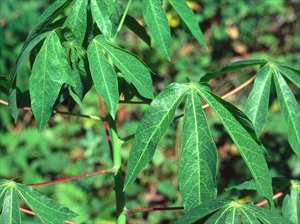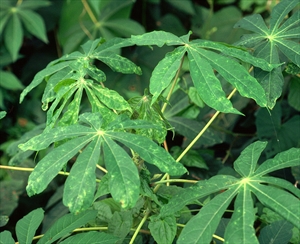Cassava green mottle
Pacific Pests, Pathogens, Weeds & Pesticides - Online edition
Pacific Pests, Pathogens, Weeds & Pesticides
Cassava green mottle (068)
Cassava green mottle nepovirus. It has not been confirmed to be a nepovirus; these are viruses that are transmitted by nematodes - hence the name.
Only known from Solomon Islands. It was first found on Choiseul in the 1970s; more recently (2010), similar symptoms were seen on Malaita. The record of the virus in Australia requires confirmation.
It is only known from cassava, and only from Choiseul (and possibly Malaita), nowhere else in the world. In the lab, several plant species have been infected with this virus; these species are known as 'indicator' plants and are used to identify and characterise many kinds of viruses: Chenopodium, Nicotiana (tobacco), Phaseolus (French bean), Cucumis (cucumber), Ricinus (castor oil) and Solanum (potato). Interestingly, Ipomoea (sweetpotato) was also infected in these tests. But whether or not infection occurs in the field is unknown.
Young leaves are puckered with faint to distinct yellow spots (Photo 1), green patterns (mosaics), and twisted margins (Photo 2). Usually, the shoots recover from symptoms and appear healthy. Occasionally, plants become severely stunted, edible roots are absent or, if present, they are small and woody when cooked.
In the lab, the virus can be passed between plants in sap, and also in seed. Thirty percent of the seed of infected tobacco plants was infected. Whether it also spreads in seed of cassava is unknown. Seed is not used for growing cassava, so spread on Choiseul is most likely in diseased cuttings. However, there are other possibilities.
In a trial on Choiseul, 4% of plants grown from cuttings taken from Guadalcanal became diseased within 250 days from planting. How this infection occurred is unknown, but there are several possibilities. Plants touching each other in the wind may have transferred sap between those infected and healthy. There is also the possibility of spread by nematodes and pollen. The virus is thought to be a member of the nepovirus group, and members of this group are spread in these ways.
Surveys on Choiseul showed that the disease is present in most plantings, but the number of infected plants is low. Cuttings taken from diseased plants are much slower to develop than those from plants without symptoms during the previous 9 months, and assumed to be healthy. There were differences between the heights of these two groups of plants at 4 months, but differences were much less at harvest at 8 months. Also, weight of stems and edible roots of diseased plants were half those planted with healthy cuttings. However, farmers usually plant three cuttings per mound, so any that stay healthy have more space and nutrients and make up for the loss in yield from those that are diseased.
Look for yellow patterns on the leaves, from small dots to irregular patches of yellow and green. Look for leaf margins that are distorted. The plants may be stunted.
QUARANTINE
Surveys carried out in Solomon Islands in the late 1970s failed to find the disease anywhere but on the island of Choiseul. It was not found in the nearby Shortland Islands. People on Choiseul were made aware of the disease and asked not to take cuttings to other islands. However, there are no laws restricting the movement of planting material between islands of the country, so compliance is voluntary. Choiseul is near the island of Bougainville in Papua New Guinea, and residents of both islands move between the two, but it is not known if the virus disease occurs in Bougainville.
CULTURAL CONTROL
Cultural control is very important, and is the main method of reducing the impact of this disease:
Before planting:
- Take cuttings for propagation only from plants that are free from symptoms and which, at harvest, produced high yields of edible roots.
During growth
- Remove plants with symptoms as soon as they are seen, and burn them. DO NOT wait until harvest, as by then the plants may have recovered from symptoms and, unless marked, difficult to identify as infected.
RESISTANT VARIETIES
None are known.
CHEMICAL CONTROL
Chemical control is not appropriate for this disease, especially as the method of spread is unknown.
AUTHORS Helen Tsatsia & Grahame Jackson
Information from CABI (2019). Cassava green mottle virus (2019) Crop Protection Compendium. (https://www.cabi.org/cpc/datasheet/17123#REF-DDB-73373). Lennon AM 1987) Annals of Applied Biology. (https://onlinelibrary.wiley.com/doi/abs/10.1111/j.1744-7348.1987.tb04172.x).
Produced with support from the Australian Centre for International Agricultural Research under project PC/2010/090: Strengthening integrated crop management research in the Pacific Islands in support of sustainable intensification of high-value crop production, implemented by the University of Queensland and the Secretariat of the Pacific Community.





